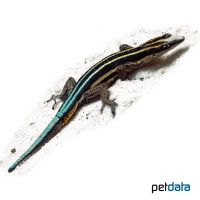Western Blue-tailed Gliding Lizard (Holaspis guentheri)
| Western Blue-tailed Gliding Lizard Holaspis guentheri | |
|---|---|
| Name | Western Blue-tailed Gliding Lizard |
| Name Lat. | Holaspis guentheri |
| Family | Lacertids |
| Family lat. | Lacertidae |
| Order | Scaled Reptiles |
| Order lat. | Squamata |
| Origin | Africa |
| Habitat | Humid savanna |
| Diet | Insects |
| Humidity | 70-90 % |
| Behavior | Peaceful |
| Keeping | Individual, pair, harem |
| Care Level | Easy |
| Reproduction | Oviparous |
| Housing | Humid terrarium |
| Life Span | 7 years |
| Protection | No |
| Metric Units | |
| Size | 12-15 cm |
| Temperature | 25-28 °C |
| Temperature Local | 35 °C |
| Housing Size | 50 x 50 x 100 cm |
| US Units | |
| Size | 4.7"-6" |
| Temperature | 77-82 °F |
| Temperature Local | 95 °F |
| Housing Size | 20" x 20" x 40" |
Distribution and habitat
The range of diurnal, arboreal saw-whet lizards extends from Sierra Leone to Angola in West Africa, through Uganda to Tanzania in East Africa. They live mainly in the humid lowland forests and open scrubland.
Maintenance
Minimum dimensions for the terrarium, according to the size and number of animals
| 1-2 animals | 6KRL x 4KRL x 4KRL (L x W x H) |
Head-torso length (KRL) is measured on the largest animal. For each additional animal, increase the footprint by 15%. A terrarium of e.g. 60 x 50 x 100 cm is recommended, which should be placed in a quiet and vibration-free place.
You need a terrarium with thin, branched climbing branches, bamboo sticks and plants, such as Ficus, Scindapsus etc. (hiding and shade places), structured back and side walls (e.g. cork covering) and a moisture retaining substrate of forest soil-peat mixture covered with leaves and bark pieces, as well as a shallow water container. Part of the substrate should always be kept slightly moist (no waterlogging). Several times a day the inside of the terrarium should be finely sprayed with water (humidity), better is a rain or mist system.
| Temp. day: 25-28 °C | Temp. night: 20-22 °C | Temp. local: up to 35 °C | Humidity: 70-90 % |
Lighting duration must be 10-14 hrs depending on the season. They need high light intensity and daily UV irradiation as well as sunny places with radiant heat.
Diet
The food supply consists of live insects, such as crickets, grasshoppers, centipedes and spiders. Often, after habituation, commercially available ready-made food for insectivorous reptiles is also accepted. Wax moths should rarely be fed in small amounts to adults, but not to juveniles, because of their large fat content. Young animals should be offered food daily, adults 4-5 times a week. Regular addition of minerals and vitamins (dusting of feed) is important. Drinking water must always be available, but is preferably ingested in drop form from leaves or furnishings (drip feeders).
A regular and varied diet promotes health and prevents deficiency symptoms.
Reproduction and breeding
Adult males are usually larger and more powerfully built than females and can be recognized by their preanal pores (pore-like openings in front of the anal cleft).
The female buries usually 2 eggs several times per year in the soft, moist substrate. At a temperature of 24-26 °C the incubation period is about 80 days. As first food for the young animals small insects like fruit flies and micro crickets are suitable
Important
They can be well maintained in a small group, one male with 2-4 females
These tree dwellers require a high terrarium. Saw-tailed lizards can leap unerringly from branch to branch, gliding up to 30 meters. They can shed their tail when in danger, which grows back without significantly affecting the animal.
They require basking sites with radiant heat, such as branches irradiated with a spotlight
The quality of the food animals can be upgraded by giving them fruit and honey water as food.
The terrarium must have good ventilation without drafts and meet the species-specific needs. Measuring devices such as thermometers, hygrometers, etc. are necessary. The lighting has to correspond to the species-specific day-night rhythm and has to be placed in such a way that the animals cannot injure themselves. The terrarium should be locked in such a way that neither unauthorized persons can open it nor the animals can escape. Contamination must be removed regularly
Further literature can be found in your pet store.
References
Text: petdata; Image: petdata
Source: BMELV (1997): Tierschutzgutachten - Mindestanforderungen an die Haltung von Reptilien; ENGELMANN (2006): Zootierhaltung - Tiere in menschlicher Obhut: Reptilien und Amphibien, Harri Deutsch Verlag
- Gemäß § 21 Abs. 5 Tierschutzgesetz idgF
